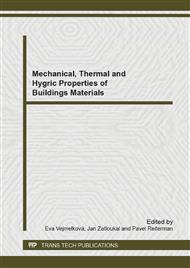p.6
p.11
p.16
p.22
p.27
p.32
p.38
p.44
p.49
Effect of Zeolite Admixture on Freeze/Thaw Resistance of Concrete Exposed to the Dynamic Climatic Conditions
Abstract:
This paper aims at computational simulation of effect of zeolite admixture on service life of concrete building envelope from point of view of freeze/thaw resistance. Hygrothermal behavior of two types of concrete is studied in this paper: reference concrete without any admixtures and zeolite concrete with 40 % zeolite as cement replacement. The computations are performed using computer simulation tool HEMOT, which processes the input parameters using finite element method. The simulation is assumed under dynamic climatic conditions of Prague. As the results of the computational simulations showed, assuming analyzed amount of zeolite, any positive effect of on freeze/thaw resistance was not found related to unprotected building envelope. However, the results indicated, hygrothermal performance of zeolite concrete can be very considerate to applied external layers and thus extend their service life.
Info:
Periodical:
Pages:
27-31
Citation:
Online since:
July 2014
Authors:
Price:
Сopyright:
© 2014 Trans Tech Publications Ltd. All Rights Reserved
Share:
Citation:


